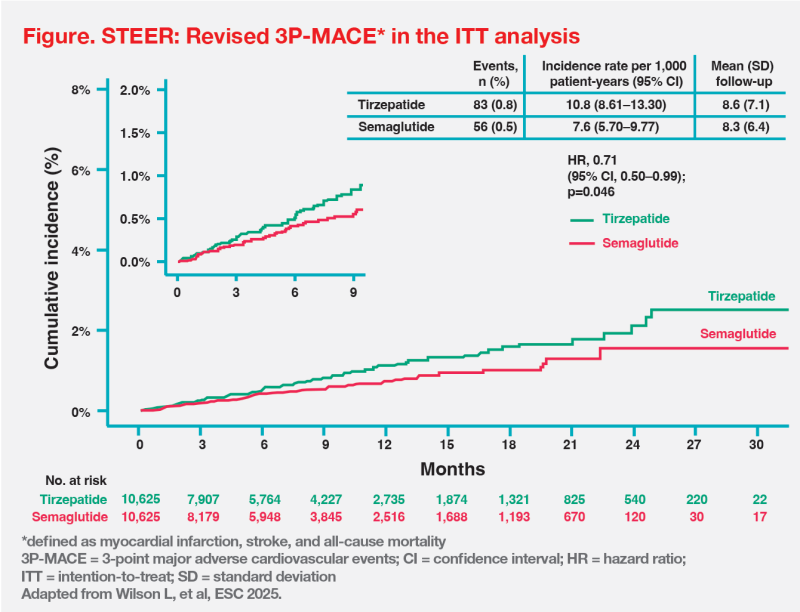ESC 2025: Semaglutide cuts MACE risk by 57 percent vs tirzepatide in patients with obesity and ASCVD





Compared with tirzepatide, subcutaneous semaglutide 2.4 mg is associated with a 57 percent lower risk of revised 3-point major adverse cardiovascular events (3P-MACE; defined as MI, stroke, and all-cause mortality [instead of cardiovascular-related death]) in a population similar to the SELECT trial — patients with overweight or obesity and established atherosclerotic cardiovascular disease (ASCVD) but no history of diabetes, according to results of the real-world STEER trial presented at the European Society of Cardiology (ESC) Congress 2025.
Semaglutide: The only obesity treatment for secondary prevention of CVD
“Currently, semaglutide is the only long-term weight management treatment indicated to reduce the risk of MACE in adults with overweight or obesity and established CVD,” said Ms Lauren Wilson from Novo Nordisk, Inc., Plainsboro, New Jersey, US, at ESC 2025. This indication is supported by a 20 percent reduction in risk of traditional 3P-MACE (MI, stroke, and CV-related death) vs placebo observed in the phase III, double-blind, randomized, placebo-controlled SELECT trial. [www.fda.gov/news-events/press-announcements/fda-approves-first-treatment-reduce-risk-serious-heart-problems-specifically-adults-obesity-or; N Engl J Med 2023;389: 2221-2232; Wilson L, et al, ESC 2025]
The US FDA approved tirzepatide for long-term weight management in November 2023. [www.fda.gov/ news-events/press-announcements/ fda-approves-new-medication-chronic-weight-management] “There is an ongoing CV outcomes trial in patients with or at risk of ASCVD who do not have diabetes. However, tirzepatide is not currently indicated for CV risk reduction [in this population],” pointed out Wilson.
STEER: CV outcome study of semaglutide vs tirzepatide
The STEER study evaluated the real-world incidence of MACE during treatment with semaglutide 2.4 mg or tirzepatide for long-term weight management in routine clinical practice in the US. The primary endpoints were revised 3P-MACE and revised 5-point MACE (5P-MACE; ie, MI, stroke, hospitalization for heart failure, coronary revascularization, and all-cause mortality). [Wilson L, et al, ESC 2025]
SELECT-like population
Using the US Komodo Research Database, patients aged ≥45 years with pre-existing ASCVD and overweight or obesity (body mass index [BMI] ≥27 kg/ m2), but no history of diabetes, were identified. Patients who initiated semaglutide 2.4 mg or tirzepatide on or after 13 May 2022 were matched 1:1 using a propensity score model and followed up until 31 January 2025. The real-world STEER study population resembled the SELECT trial’s population. [Wilson L, et al, ESC 2025; N Engl J Med 2023;389: 2221-2232]
“Strengths of STEER included the large sample size, with 10,625 patients in both the semaglutide 2.4 mg [mean age, 58.5 years; female, 61.8 years; median follow-up, 8.3 months] and tirzepatide [mean age, 58.3 years; female, 61.6 years; median follow-up, 8.6 months] groups, and the well-balanced cohorts across many comorbid conditions and concomitant medications,” Wilson noted.
ITT analysis: 29 percent risk reduction in revised 3P-MACE with semaglutide
In the intention-to-treat (ITT) analysis, patients were followed through the end of follow-up, regardless of persistence on therapy.
Semaglutide 2.4 mg significantly reduced the risk of revised 3P-MACE by 29 percent vs tirzepatide. (Figure)

Additionally, the risk of revised 5P-MACE was lower with semaglutide 2.4 mg vs tirzepatide (incidence rate [IR], 16.7 vs 21.0 per 1,000 patient-years [PY]; hazard ratio [HR], 0.78; 95 percent confidence interval [CI], 0.62–0.99; p=0.04) in the ITT analysis.
In real-world settings, the International Classification of Diseases (ICD) codes can be prone to errors and misclassification of diagnosis. As mortality can be determined without outcome ascertainment bias and life extension is the ultimate goal of most treatments, using the revised 3P-MACE definition that includes MI, stroke, and all-cause mortality (instead of CV-related death) offers a more complete and less biased assessment of outcomes in real-world studies. [BMC Med Res Methodol 2021;21:241; Diabetes Care 2017;40:1144-1151]
PP analysis: Semaglutide cuts revised 3P-MACE risk by 57 percent
In the per-protocol (PP) sensitivity analysis, patients were censored at treatment discontinuation, which was defined as a gap in therapy of >30 days.
Of note, semaglutide 2.4 mg was associated with a 57 percent reduction in risk of revised 3P-MACE vs tirzepatide in the PP analysis. (Table)

“Since there was no death in the PP analysis, results of revised 3P-MACE were equivalent to those of traditional 3P-MACE,” Wilson pointed out.
“We observed a similar trend in revised 5P-MACE in the PP analysis, with an early separation of Kaplan-Meier curves,” reported Wilson. Semaglutide 2.4 mg consistently reduced the risk of 5P-MACE by 43 percent (IR, 12.3 vs 21.1 per 1,000 PY; HR, 0.57; 95 percent CI, 0.39–0.83; p=0.003) vs tirzepatide.
Since the real-world study is retrospective in nature, it is susceptible to potential unmeasured confounding. Another limitation is the relatively short follow-up duration.
Final thoughts
In summary, semaglutide 2.4 mg was superior to tirzepatide in reducing 3P-MACE and 5P-MACE in both PP and ITT analyses in patients with overweight or obesity and established ASCVD but no history of diabetes. “Our findings support the growing evidence that the established CV benefit of semaglutide is molecule-specific and cannot be generalized to glucagon-like peptide-1 [GLP-1] or glucose-dependent insulinotropic polypeptide [GIP]/GLP-1 receptor co-agonist classes,” emphasized Wilson.
“Although STEER did not investigate the underlying mechanism behind the reduction in MACE with semaglutide, a prespecified analysis of the SELECT trial indicated that the decrease in MACE with semaglutide was independent of weight loss,” she added. [Wilson L, et al, ESC 2025; Obes Facts 2024;17:7-515]